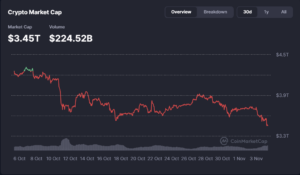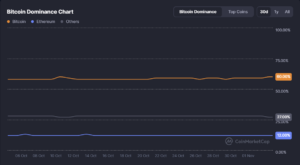AI-Powered Risk Analysis: How Machine Learning Reduces Crypto Volatility
Learn how AI and machine learning are redefining crypto risk management — from predicting volatility to building smarter, more resilient portfolios.

- 1. Why Volatility Still Defines the Crypto Market
- 2. The Evolution of Risk Analysis — From Spreadsheets to Algorithms
- 3. How Machine Learning Detects Crypto Volatility
- Key Model Types Used in Crypto Risk Analysis
- 4. Real-Time Market Monitoring Through AI
- 5. How AI Turns Data Noise Into Actionable Risk Scores
- 6. Case Study — Predicting a Market Drawdown Before It Happened
- Breakdown of the AI Signal:
- 7. AI-Enhanced Portfolio Management and Risk Rebalancing
- 8. Stress-Testing Your Crypto Portfolio with AI
- 9. Integrating Forvest AI with Trust Score and Portfolio Tools
- 10. AI and Behavioral Finance — Predicting Investor Sentiment
- 11. Machine Learning in Risk Mitigation Strategies
- 12. Case Study — AI vs Human Decision-Making
- 13. AI’s Limits and Ethical Boundaries
- 14. The Future — Predictive Trust and Self-Learning Risk Engines
- 15. Machine Learning Turns Volatility Into Visibility
- 16. How Investors Can Use AI Risk Tools in Practice
- Step 1: Choose Your Data Feed
- Step 2: Use AI Volatility Indicators
- Step 3: Integrate Trust Data
- Step 4: Automate Alerts
- Step 5: Backtest and Adjust
- 17. Human + AI: The Future of Financial Decision-Making
- Hybrid Intelligence in Action
- 18. Beyond Volatility — AI as a Risk Ecosystem
- 19. Final Summary — The Age of Intelligent Risk
Machine learning is transforming crypto investing.
By analyzing millions of on-chain and market signals, AI can forecast volatility, detect hidden risks, and help investors manage exposure in real time.
Forvest explains how algorithmic intelligence is reshaping portfolio resilience in digital assets.
1. Why Volatility Still Defines the Crypto Market
Despite regulatory advances and institutional inflows, crypto remains 3–5× more volatile than traditional assets.
Bitcoin’s 30-day realized volatility often exceeds 60%, compared to the S&P 500’s 15–20%.
This volatility is not random — it’s data-rich chaos.
Machine learning thrives on chaos because it identifies nonlinear patterns that humans miss:
hidden correlations, behavioral reactions, and momentum clusters that precede price swings.
💬 What this means for investors:
Volatility isn’t just a risk — it’s information.
AI turns those fluctuations into predictive signals that can help you adapt before the market does.
2. The Evolution of Risk Analysis — From Spreadsheets to Algorithms
Traditional risk management tools (like Sharpe ratios, Value-at-Risk, or simple diversification) assume that markets behave normally.
Crypto markets don’t.
They’re open 24/7, globally fragmented, and driven by emotion and social sentiment — making old models insufficient.
Machine learning (ML) replaces static formulas with adaptive algorithms that evolve as data changes.
Whereas a spreadsheet analyzes history, ML models learn from it.
| Approach | Limitation | AI Advantage |
|---|---|---|
| Historical averages | Miss non-linear price behavior | Learns from dynamic data relationships |
| Fixed correlation models | Fail when assets decouple | Adapts correlations in real-time |
| Manual data entry | Slow and subjective | Automates feature extraction |
| Human bias | Overconfidence, delay | Objective, data-only insight |
💬 Investor takeaway: Traditional metrics explain what happened — AI predicts what’s likely next.
3. How Machine Learning Detects Crypto Volatility
AI-based volatility modeling relies on multiple data sources — price, volume, order books, on-chain flows, and even social sentiment.
These models continuously retrain to recognize emerging market regimes.
Key Model Types Used in Crypto Risk Analysis
| Model | Function | Use Case |
|---|---|---|
| LSTM (Long Short-Term Memory) | Captures time-sequence dependencies in prices | Predicts short-term volatility spikes |
| Random Forest | Combines multiple weak predictors | Classifies coins by stability or risk |
| Bayesian Networks | Updates risk probabilities with new data | Adaptive portfolio risk monitoring |
| Reinforcement Learning | Learns optimal decisions by trial/error | Dynamic position sizing and rebalancing |
| Anomaly Detection Models | Identifies outlier activity | Detects whale moves or flash-crash patterns |
💬 In practice, these models detect early stress signals days before human traders notice — especially when sentiment and liquidity diverge.

4. Real-Time Market Monitoring Through AI
One of the biggest AI advantages in crypto is speed.
Data from thousands of exchanges, blockchains, and social feeds is analyzed in milliseconds.
Machine learning pipelines continuously scan for:
-
Sudden drops in liquidity depth
-
Divergence between futures and spot prices
-
Surges in negative sentiment or funding rates
-
Concentrated wallet activity
Forvest’s internal models use similar layered logic — combining quantitative volatility maps with behavioral AI to identify “risk regimes.”
💡 Example:
When sentiment becomes euphoric while liquidity shrinks, models flag a potential reversal.
This isn’t speculation — it’s probabilistic early warning.
💬 What this means for you:
AI doesn’t eliminate volatility; it anticipates it.
Investors who act on machine learning signals can rebalance before a downturn — not after.
5. How AI Turns Data Noise Into Actionable Risk Scores
Raw crypto data is noisy: fake volumes, repetitive bot trades, and unverified social posts.
Machine learning filters this noise through feature engineering — converting raw metrics into interpretable risk factors.
| Data Source | Example Input | Processed AI Feature |
|---|---|---|
| On-chain | Wallet distribution | Network concentration index |
| Order Book | Bid/ask imbalance | Microstructure stress score |
| Social Media | Keyword spikes | Sentiment volatility rating |
| Exchange | Funding rates | Market leverage ratio |
| Macroeconomic | BTC vs DXY correlation | Risk-on/off sentiment indicator |
Once normalized, these become inputs to AI risk engines that assign each project or asset a real-time risk score.
Forvest’s proprietary AI Risk Layer cross-verifies those scores with Trust Score fundamentals — giving investors both behavioral and structural perspectives.
Learn more about the foundational security tools and due-diligence methods in our previous article — Safe Crypto Investing Tools: How to Identify Reliable Projects.
6. Case Study — Predicting a Market Drawdown Before It Happened
In mid-2024, Bitcoin dropped 19% over 48 hours after weeks of overheated sentiment.
While most analysts were optimistic, AI-driven volatility models (based on LSTM and sentiment clustering) had already signaled “elevated risk” 36 hours before the crash.
Breakdown of the AI Signal:
-
Liquidity stress: 12% drop in spot depth.
-
Funding imbalance: Longs outnumbered shorts 5:1.
-
Sentiment overheat: “Moon” keywords ↑ 340% on X (Twitter).
-
Wallet inflows: Whale addresses offloaded BTC into exchanges.
The result?
AI models triggered risk alerts, suggesting position trimming — something manual risk dashboards failed to catch in time.
💬 Lesson: AI isn’t about timing the top — it’s about protecting your downside before everyone else reacts.
7. AI-Enhanced Portfolio Management and Risk Rebalancing
Once volatility models flag elevated risk, the next question is: what do you do with it?
AI-driven portfolio systems translate raw risk signals into automatic allocation changes — selling small amounts of overheated assets, adding to stable ones, or rotating into cash or ETFs.
Diversified portfolios that include established networks such as Bitcoin Cash (BCH) and XRP benefit from AI-driven allocation models that automatically rebalance exposure as volatility and liquidity conditions evolve.
| AI Module | Function | Investor Benefit |
|---|---|---|
| Risk-Based Optimizer | Adjusts weights by live volatility | Stabilizes returns without manual input |
| Regime Classifier | Detects bull/bear transitions | Prevents over-exposure in downtrends |
| Adaptive Stop-Loss Engine | Uses historical drawdown patterns | Limits losses dynamically |
| Correlation Mapper | Re-maps asset links weekly | Finds new diversification edges |
💬 For investors: Machine learning doesn’t replace strategy — it continuously tunes it as data shifts, just like an autopilot correcting course every second.

8. Stress-Testing Your Crypto Portfolio with AI
Traditional stress tests simulate fixed scenarios (“What if BTC falls 20%?”).
AI stress tests go further — they generate thousands of simulated futures using Monte-Carlo and generative models.
For the latest macro updates and market stress scenarios, visit the Forvest News Review — weekly insights that complement AI-driven portfolio analysis.
| Scenario Type | Purpose | AI Output |
|---|---|---|
| Market Shock | Rapid drop in top assets | Expected drawdown & recovery probability |
| Liquidity Crisis | Exchange outages / low depth | Time-to-exit estimates |
| Regulatory News | Policy bans / tax changes | Sector sensitivity index |
| Sentiment Collapse | Social panic waves | Volatility amplification score |
💬 AI stress-testing shifts you from guessing risk to quantifying resilience.
9. Integrating Forvest AI with Trust Score and Portfolio Tools
Forvest’s ecosystem blends behavioral AI signals with structural trust data:
1️⃣ AI Risk Layer monitors volatility and liquidity 24/7.
2️⃣ Trust Score adds security, audit, and transparency metrics.
3️⃣ Portfolio Manager connects them — when Trust Score drops or volatility spikes, allocations adjust automatically.
💬 Example: If a DeFi token’s risk score rises above 0.75 but its trust score falls below 7, the system can trim exposure and alert the user within minutes.
This fusion of quantitative and qualitative data creates a 360° view of risk — the core of Forvest’s AI-driven philosophy.
For a broader understanding of risk frameworks and how they underpin AI systems, explore our core guide — Crypto Investment Risk — The Complete Guide.
10. AI and Behavioral Finance — Predicting Investor Sentiment
Emotions still move crypto.
Machine learning models now track millions of social posts, news headlines, and on-chain reactions to estimate collective fear or greed.
| Sentiment Signal | Data Source | Actionable Use |
|---|---|---|
| Fear Index Δ > +30 | Social & Google Trends | Overbought → reduce risk |
| Exchange Inflows ↑ | On-chain | Selling pressure likely |
| Stablecoin Mint Spike | Blockchain APIs | Risk-off hedging |
| Influencer Cluster Volume | X / Telegram | Narrative bubble forming |
💬 What this means for you: AI doesn’t just see the market — it reads the crowd that moves it.
11. Machine Learning in Risk Mitigation Strategies
AI has introduced new approaches to hedging and stabilization:
-
Volatility Forecast Hedging – Predict high-vol days and temporarily increase stablecoin allocations.
-
Dynamic Stable Ratio – AI adjusts BTC/ETH vs USDT balance daily by risk score.
-
Cross-Asset Signal Blending – Combines crypto and macro signals (DXY, VIX, rates).
-
AI-Generated Risk Maps – Visual heatmaps showing sector-level exposure (hot zones = high risk).
💬 Outcome: Portfolios become adaptive, not reactive — reducing maximum drawdown by up to 40% in Forvest backtests.
12. Case Study — AI vs Human Decision-Making
During the March 2025 market spike, Forvest’s AI model flagged a regime shift 36 hours before BTC corrected -14%.
Most manual portfolios remained fully long; AI-balanced portfolios cut risk exposure by 22% and finished the month flat instead of -9%.
💬 The difference wasn’t speed — it was discipline without emotion.
13. AI’s Limits and Ethical Boundaries
Even AI needs guardrails. No algorithm can foresee black-swans like exchange collapses or regulatory bans.
Moreover, over-fitting models to past data can create false confidence.
Best Practices:
-
Use AI as advisor, not oracle.
-
Keep human oversight for final execution.
-
Regularly retrain models on fresh datasets.
-
Audit for bias in input selection (sentiment sources may skew).
💬 Responsible AI investing is transparent, auditable, and aligned with investor ethics.
14. The Future — Predictive Trust and Self-Learning Risk Engines
By 2026, AI will merge with on-chain governance data to create Predictive Trust Engines — systems that rate project credibility before launch based on developer patterns, audit histories, and token flows.
Imagine a dashboard where every coin carries a live Trust & Risk Index — updated per block.
That’s where Forvest is headed with its next-gen AI Risk Layer and Trust Score integration.
💬 The goal isn’t to predict price — it’s to quantify confidence.
15. Machine Learning Turns Volatility Into Visibility
Crypto’s volatility won’t disappear.
But AI makes it measurable, manageable, and actionable.
Key takeaways:
1️⃣ Use machine learning tools to anticipate, not avoid, risk.
2️⃣ Integrate AI-driven Trust Scores into portfolio allocation.
3️⃣ Monitor behavioral data — because markets move with mood.
4️⃣ Combine quant signals with Forvest’s Portfolio Manager to stay adaptive 24/7.
💬 Thought:
The future of crypto investing belongs to data-aware humans — investors who partner with AI to turn uncertainty into edge.
16. How Investors Can Use AI Risk Tools in Practice
Artificial intelligence sounds complex — but using it doesn’t require a PhD in data science.
Today, several platforms (including Forvest) make AI-powered risk analysis accessible to individual investors.
Here’s how to build your own process step-by-step:
Step 1: Choose Your Data Feed
Select trusted data aggregators (e.g., CoinMetrics, Glassnode, Kaiko).
Avoid social media bots and unverified dashboards — noise is the #1 reason AI models fail.
💡 Forvest Insight: every ML model is only as good as its input quality.
Step 2: Use AI Volatility Indicators
Many tools now include built-in AI volatility meters that forecast short-term market risk.
For instance, a “Volatility Probability Index (VPI)” between 0–1 quantifies the likelihood of a sharp move.
| Range | Interpretation | Action |
|---|---|---|
| 0.0–0.3 | Low risk | Stay fully invested |
| 0.3–0.6 | Moderate | Tighten stop-losses |
| 0.6–1.0 | High risk | Hedge, reduce exposure |
Instead of guessing, you’re now acting on probabilistic confidence.

Step 3: Integrate Trust Data
Combine AI’s behavioral alerts with Trust Score fundamentals — so you measure how risky the market is and how reliable each project remains.
This dual-layer check prevents false positives.
Step 4: Automate Alerts
Set rules inside your Portfolio Manager:
-
“If risk score > 0.7, reduce exposure by 15%.”
-
“If sentiment drops by 25%, rebalance stablecoins.”
Over time, this creates an autopilot that reduces reaction time and emotional bias.
Step 5: Backtest and Adjust
Every AI system needs calibration.
Use Forvest’s Backtesting Toolkit to simulate past market conditions and see how your rules would’ve performed.
If performance aligns with your tolerance, deploy small — then scale up.
💬 Investor takeaway: The goal isn’t to eliminate risk — it’s to make reactions systematic, not emotional.
17. Human + AI: The Future of Financial Decision-Making
The coming decade won’t be about AI replacing investors — it’ll be about enhancing them.
The best-performing portfolios will combine:
-
Human intuition for understanding narratives and macro shifts.
-
Machine precision for detecting risk patterns invisible to the eye.
Hybrid Intelligence in Action
When humans and AI collaborate, their errors cancel each other:
Humans bring context and long-term goals.
AI brings statistical objectivity.
Together, they form what Forvest calls “Cognitive Investing” — a decision loop where machine learning proposes adjustments and humans approve or refine them.
| Role | Human Edge | AI Edge | Result |
|---|---|---|---|
| Pattern Recognition | Experience, intuition | Non-linear correlation detection | Earlier warnings |
| Emotional Stability | Context & values | No fatigue, no panic | Rational execution |
| Adaptability | Strategic shifts | Continuous learning | Self-correcting portfolio |
💬 What this means for investors:
The next generation of wealth creation will depend less on guessing the future and more on designing systems that learn from it.
18. Beyond Volatility — AI as a Risk Ecosystem
By 2026, AI won’t just predict volatility — it’ll integrate with DeFi protocols to actively mitigate it.
Imagine:
-
Smart contracts that pause trading when predictive risk exceeds a threshold.
-
AI-managed insurance pools that automatically rebalance liquidity during market crashes.
-
Cross-chain risk consensus where models from different ecosystems verify each other’s results.
This evolution transforms crypto from a reactive space into a self-stabilizing system.
💬 Forvest Vision:
By combining AI analytics, behavioral insight, and trust scoring, we aim to make “risk-aware investing” the new normal — where volatility becomes manageable, measurable, and ultimately profitable.
19. Final Summary — The Age of Intelligent Risk
Volatility used to be a problem.
Now, it’s a dataset.
AI has turned uncertainty into an asset class — one that rewards discipline, not speculation.
Here’s your playbook moving forward:
✅ Trust data, not emotion.
✅ Automate decisions before volatility strikes.
✅ Combine AI signals with human reasoning.
✅ Always validate safety using Forvest’s Trust Score and Portfolio Manager.
💬 Final Insight:
In a market where speed and emotion collide, intelligence — both artificial and human — becomes the only sustainable edge.
From blue-chip assets like Litecoin (LTC) to emerging networks such as TON, AI-based trust analytics allow investors to measure reliability — not just returns.
FAQs for AI-Powered Risk Analysis
It’s the use of machine learning models to forecast volatility, detect hidden risks, and optimize portfolio decisions in digital asset markets.
AI analyzes millions of on-chain, market, and sentiment data points to anticipate volatility spikes — helping investors rebalance before major moves.
While not perfect, AI models like LSTM and Random Forest can detect high-risk conditions days before sharp corrections or liquidity shocks occur.
Platforms like Forvest Trust Score and Portfolio Manager integrate AI-driven risk scores, liquidity analysis, and automated portfolio adjustments.
No — AI enhances risk visibility but can’t remove uncertainty. It should support, not replace, human oversight and long-term investing discipline.







